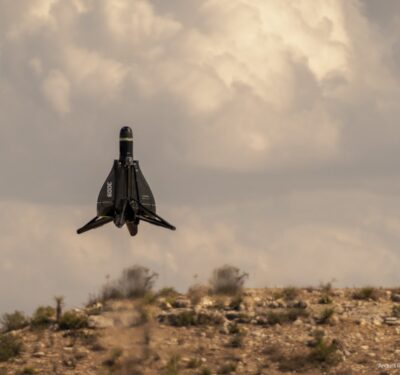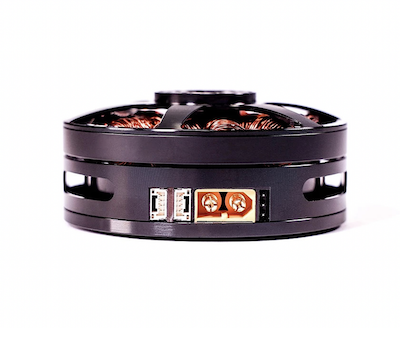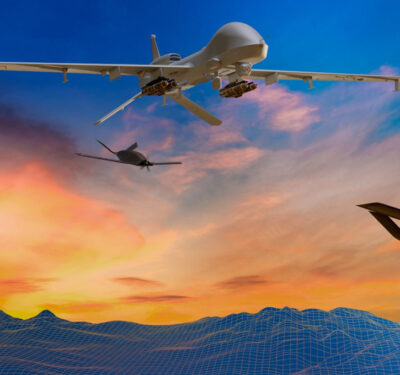
Nearly 15 years ago, the eight-lane Interstate 35W bridge over the Mississippi River in downtown Minneapolis collapsed during evening rush hour, a disaster that sent cars, trucks and even a school bus plunging into the river and rocky shore below. Thirteen people were killed and 145 more were injured, a tragedy that underscored the importance of regular inspections of critical infrastructure.
Increasingly, drones are overcoming major technical challenges to help inspect bridges, work that may ultimately help prevent further catastrophic failures.
“We have a major infrastructure problem in this country right now, and being able to recognize and remediate any risk this poses will be vital,” said Jeffery Alholm, CEO of Lenexa, Kansas-based drone startup Digital Aerolus. “As an engineer and scientist, I expect entropy—things go from order to disorder. It’s the way of life. And we have to be able to get trained eyes to judge any important degradation, which drones can help do.”
Ideal for inspections
When it comes to bridge inspections, drones offer the chance to reduce costs, speed review, provide better data and improve worker safety, as they have across many other sectors.
“There are over 614,000 bridges in the U.S.,” Alholm said. “People talk about drones taking jobs away. My answer is, ‘Hell, no.’ There are more bridges than people have time to inspect right now.”
The primary piece of equipment currently used to inspect bridges is a “snooper truck”—an inspection vehicle that uses buckets or platforms on booms to lower workers under bridges. Each one may cost $200,000 to $500,000 and require a large crew to operate. “If mishandled in any way, the snooper truck can tip over,” said Adam Bry, CEO of Redwood City, California-based drone startup Skydio. In other cases, inspections may involve workers rappelling on ropes from bridges.
“Compared to rappelling, or a many-ton piece of machinery, a small light drone seems more safe and efficient,” Bry said.
The lane closures often needed for conventional bridge inspections can lead to traffic detours and traffic jams. “Drones are a less expensive way to get similar results to traditional bridge inspections, and we don’t have to play in traffic, which is nice, having safety for my crew,” said Bob Blunt, a bridge engineer and bridge inspector for civil engineering consulting and design firm VHB, which has more than 30 U.S. locations.
Drones can also help inspectors gather far more detail than conventional methods. “We can fly close to structures and get good vantage points that might be difficult or impossible to reach without drones,” Bry said.
Blunt recalled his introduction to the value of drones for bridge inspection. “In 2015, I was in a boat under a bridge in Maine with a pair of binoculars performing a routine bridge inspection, and I noticed a bearing more offset than maybe it should be. I had no way of going there, and I didn’t want to close down Route 1 at the height of tourist season,” Blunt said. “I thought how it would have been great if I had a drone, and that’s how I got into using them for my work. For me, it’s about always wanting to do a better and more thorough job.”
Such views from drones can prove vital. “We’re seeing perspectives of bridges we couldn’t get before,” said Anthony Darlington, a technical specialist for VHB. “For instance, we had a bridge five feet off the water. Since there was a strong current and there was a dam 50 feet downstream from it, there were not many inspections done underneath this bridge before because of the risks. I chose a tiny drone, a DJI Mavic Air, to fly under there and get images never seen before, something just not feasible with a boat or an under-bridge vehicle. But even though this bridge was young, we found these big chunks of concrete were falling out from it. So that was important.”

The Aertos 130IR drone from Digital Aerolus.
The Minnesota Department of Transportation has found that a conventional bridge inspection employing eight inspection days and three snooper trucks costs roughly $59,000. In contrast, the same inspection using a drone would require only two workers, a pilot and a spotter, and can be completed in a few hours. “Depending on the bridge, we can see a 40 to 60 percent savings on cost using drones,” said Jennifer Wells, the state bridge inspection engineer for Minnesota and lead investigator on the Minnesota Department of Transportation’s drone research program for bridges.
“If you see something a little off with the drone, it may warrant going back with an under-bridge inspection truck and a lane closure,” Blunt said. “But they can really reduce the need for such measures.”
In addition, drone software can analyze images automatically, helping measure the length of any detected cracks during bridge inspections, Wells said. In the future, drones may also perform non-destructive testing of bridges with thermal cameras and other sensors to detect hidden damage, she added.
All in all, “drones can capture data from bridges in ways vastly superior to the mostly ad hoc techniques often used now,” Bry said. “Some people take lots of pictures, some just take notes. What you end up with, even if people did well, is often a spotty and incomplete record. On the other hand, drones can capture a full digital record of a structure.”
Unmanned aircraft are finding use in tunnel inspection as well. For example, sewer inspections are notoriously difficult, time-consuming and hazardous work, involving surveys of vast networks of dark narrow tunnels with low ceilings that often cause posture-related injuries, potentially in the presence of toxic or explosive gases. Tests of the ARSI (Aerial Robot for Sewer Inspection) project from Catalonia’s technology center Eurecat suggested drones could quickly navigate sewer tunnels in Barcelona, inspecting 300 meters in 10 minutes and potentially 2.4 kilometers per day.
Drone startup Hovering Solutions in Europe also developed a drone to help produce 3D maps of tunnels in the heart of London, under its Canary Wharf business district. Such tests were part of Crossrail, the construction project that aims to provide suburban rail passenger service crossing London from west to east. “Drones are much faster, safer and absolutely more accurate than conventional tunnel inspections, so there are significant efficiency and safety gains,” said Jan Spaniol, Hovering Solutions’ chief operating officer.
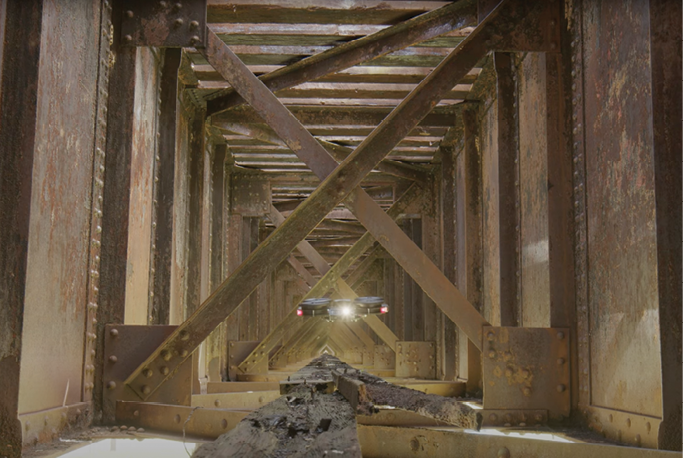
An Aertos drone from Digital Aerolus flying within a bridge.
Challenging Tasks
However, conventional drones face numerous challenges with such inspections. For example, most drones rely on GPS for stable autonomous flight, but GPS signals generally require an uninterrupted line of sight and do not penetrate metal. The metal in many bridges can also interfere with the magnetic sensors many drones use to support navigation. “Once a drone flies under a bridge, the stability and guidance systems on most drones completely fail,” Bry said.
Manually flying drones for bridge inspections presented many problems as well. The undersides of bridges are often windy and dark, often with tight confined spaces rich in obstacles, making them difficult to navigate. Bridges also often hang over water, which poses a hazard to the drone, or over roads, which raises risks to civilians.
“If you do fly drones manually under bridges, you need a world-class pilot to fly,” Bry said.
Because manual flight is difficult, inspection protocols for such missions often call for long distances from their surroundings to increase a pilot’s margin for error. This results in poorer images, so inspectors may have to compensate with increasingly expensive cameras to capture better pictures.
In addition, when drones first began proving useful in bridge inspections, about five years ago, most drones could not angle their cameras upwards. “That’s not helpful when you are trying to look underneath a bridge,” said Wells, the Federal Highway Administration’s drone committee’s structure expert.
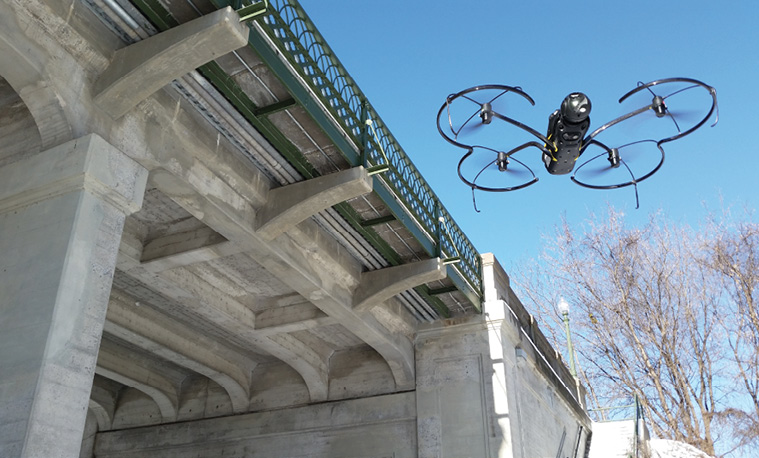
Technological Advances
Luckily, drone technology has quickly advanced to overcome these challenges. “Every year, UAS become more and more capable,” Blunt said. “It’s been fun to see the technology change at such a rapid pace. We often dream of something in the field we would like to see, and the next year it’s available on a drone, like they’ve been reading our minds.”
For example, Digital Aerolus noted its Aertos family of drones were ideal for bridge inspections because they were designed to fly stably on their own even without external data from GPS and magnetic sensors.
“Instead of adding more and more sensors to our drones to help them know where they are in reference to the world, the world view of our drones is managed relative to themselves,” Alholm said. “If we made all the sensors fail on our drones, they could still fly stably.” Moreover, the Aertos drone controller “has an Nvidia array with 128 GPUs for image and data processing—you’re essentially holding a supercomputer when you are flying our drone.”
Skydio also has designed its drones for stable autonomous flight without GPS and magnetic sensors. “We built our systems from the ground up based on computer vision,” Bry said. “Our Skydio 2 drone has six 4K cameras with fisheye lenses for navigation, three on top, three on bottom, for a complete view of its surroundings.
“We also have a really powerful CPU-GPU combination on board, for the most powerful computer you can fit on something that small and light,” Bry noted. “The software can then use the visual data from the cameras to fix on features and track them over time, triangulating them to figure out centimeter-level accurate estimates of where the drone is and how it is moving. It then estimates the three-dimensional map of the world through a deep neural network to make sure it does not run into anything.”
Such capabilities now support increasingly autonomous bridge inspections, with users programming flight plans into drones and inspecting the data afterward. “With a world-class drone pilot and a world-class bridge inspector, you can gather great data, but if not, your results might be lacking,” Bry said. “We are trying hard to automate the process of bridge inspection in a scalable, repeatable way.”
In addition, an increasing number of drones offer cameras that can look up. “We don’t have to drill holes into a drone anymore to place a camera system on top of it and wish for the best,” Darlington said.
The emergence of LED lights on drones can also illuminate areas under bridges. “Supplemental lighting was a big game-changer,” Blunt said. Darlington of VHB agreed. “Lighting up here in Maine can be an issue,” Darlington said. “How long is our daytime in the winter? Only a couple of hours. And the sun is never in the right spot. So whenever you can put lighting on top of a drone as well as a camera, getting better image quality of cracks is very, very important to us. The ability to attach an actual light source to a drone, as opposed to just duct-taping it, is nice.”
Recently developed collision avoidance sensors that can help drones fly indoors can prove highly useful for bridge and tunnel inspections as well. “If you are three or four feet under the deck of a bridge, movement of any type is extremely detrimental to the drone, unless you have some cage around it,” Darlington said. “So sensors that can tell you how close you are to your surroundings are definitely helpful, and not something that was reliable even two years ago.”
One technology the Minnesota Department of Transportation has investigated for bridge inspections is first-person vision goggles, which help inspectors see things from the drone’s point of view. With goggles wirelessly linked to a drone, an inspector can get a view equivalent to seeing an 18-foot, 1,080-pixel high-definition television screen from a distance of about 9 feet, helping them detect even hairline cracks. The goggles can also be set to control the drone camera’s gimbal and its angle. “We are also working with Microsoft’s HoloLens, which has an augmented reality display so we can see 3D models of bridges in front of us,” Wells said.
Drones can now also create full 3D maps of bridges that government agencies or inspection firms can later reference to help monitor for cracks and other changes over time. “You can imagine flying to the same points year after year, inspecting the same bolts to see if any rust is getting out of control, whether you need to paint it or replace it,” Alholm said.
“We do think full digital maps are going to become more and more popular,” Bry said. “You can use machine learning and other techniques to pore over complete image coverage of entire structures, give solid baselines for future inspections and maybe detect damage not intentionally looked for. It’s just a more powerful way of doing inspections.”
“It can be hard to explain to engineers in an office who never go to a bridge what our pictures are looking at, so if I can show defects in a 3D model, I can show them exactly what I am talking about and where,” Wells said. “So a 3D model would be super-useful.”
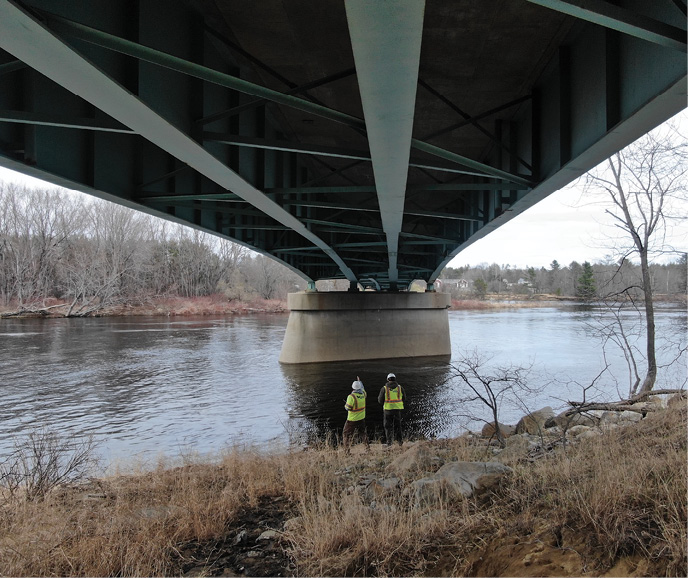
Inspectors and drone pilots with civil engineering consulting and design firm VHB use unmanned aircraft to inspect bridges.
A Growing Market
Such recent technological advances have led to a rapidly growing market for drone use for challenging inspections. “The Aertos 130IR is really designed to be the cat’s meow for bridge inspections, and it’s really taken off,” Alholm said. “I would expect our business to double or quadruple in coming months.”
Bry concurred. “We have seen a lot of rapid adoption of our drones for bridge inspection in the last year since we launched the Skydio 2,” he said. “And I think the market is still early—most bridge inspections are currently done with conventional methods.”
One sign of this advance may be how, in October, Skydio gained FAA approval for the North Carolina Department of Transportation to fly its drones beyond visual line of sight to inspect the state’s bridges, This is the first-ever state-wide waiver the FAA has given for BVLOS drone bridge inspections. “This waiver essentially explicitly recognizes the power of our autonomously flying drones,“ Bry said. “It will save the North Carolina Department of Transportation a ton of time and money by allowing them to use our drones instead of the standard heavy machinery.”
“As states become more comfortable with the use of UAS in inspections, it seems we have been busier and busier each year since we started doing this,” Blunt said.
Recently, the Minnesota Department of Transportation purchased a fleet of 17 drones for use in bridge inspection, including one large DJI Matrice 300 and 16 smaller DJI Mavic 2s. “We’re now looking for facilities for state-wide training with them by April, centrally located in the state, and indoors, so we don’t have to worry about the national airspace,” Wells said.
As part of research for the Federal Highway Administration, Blunt and Darlington noted they practiced drone bridge inspection flights at the University of Maine’s Transportation Infrastructure Durability Center, which possesses a giant GPS-denied indoor space with an industrial fan over a massive wave pool where they model offshore structures. The duo spent two days performing tests at different wind speeds and lighting conditions, seeing which distances from an object might yield optimal images, as well as other variables.
“Even as an experienced UAS operator, it was extremely beneficial for myself to see the limitations of the technology and put it through its paces,” Darlington said. “The risk factor of flying over water was great. If I had the ability to train my operators in such a facility, hands down I would take it.”
In the future, “I think there is room for way more automation in inspections,” Bry said. “At maturity, drones are going to not only transform bridge inspection work, but most civil engineering and infrastructure maintenance.”
Still, “I don’t think drones aren’t going to replace all bridge inspectors,” Darlington said. “There are some kinds of bridges that you probably shouldn’t use drones with, such as truss bridges, because of their complexity. There are too many details with them, so you start getting bogged down, and the time and cost involved might not be as effective as you might hope, so it’s probably better to just get an under-bridge inspection truck or a type of boat.”
“But for routine inspections, drones are unbelievable, especially for larger bridges,” Darlington added. “It’s a matter of finding out where they fit.”



